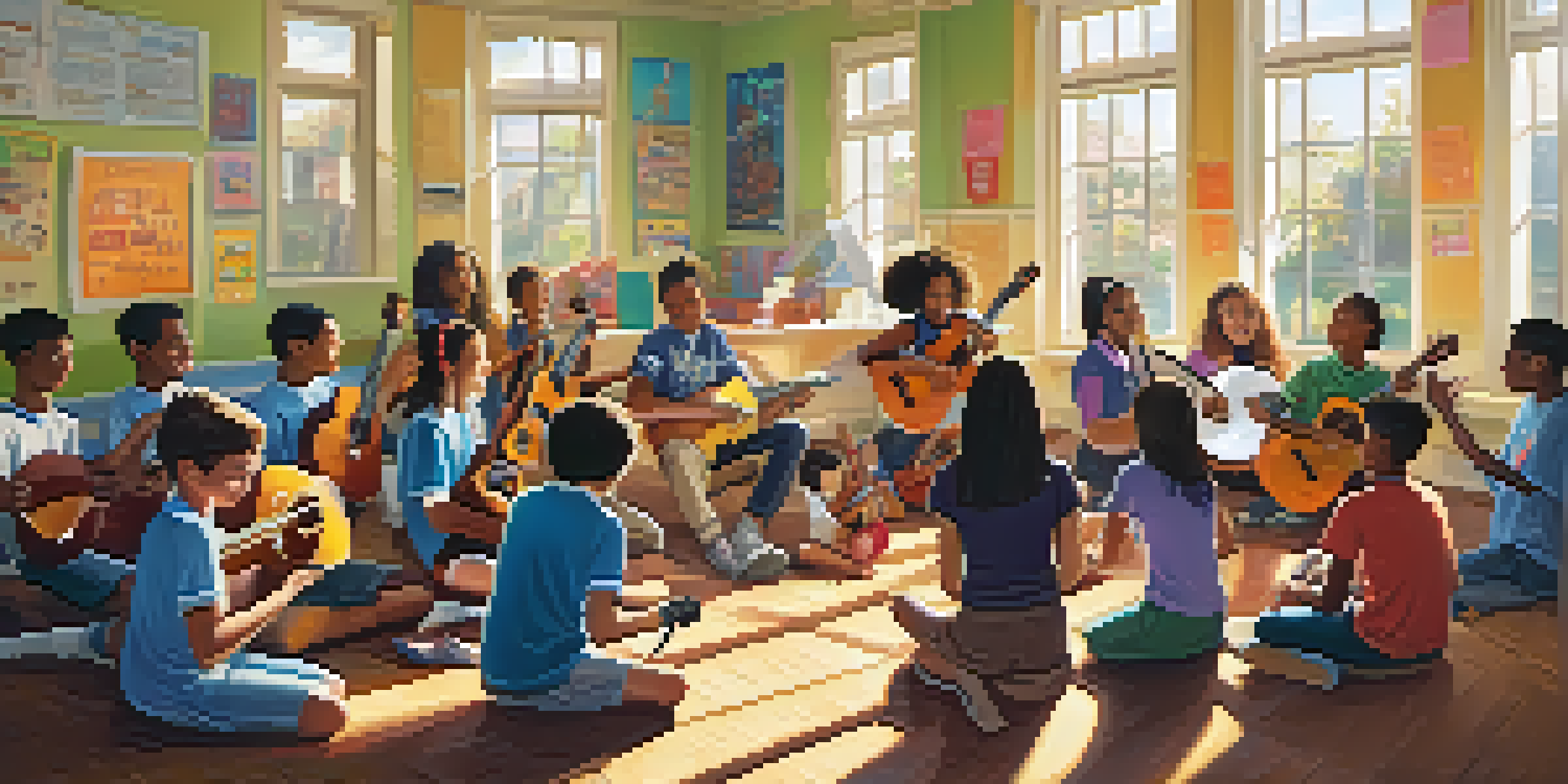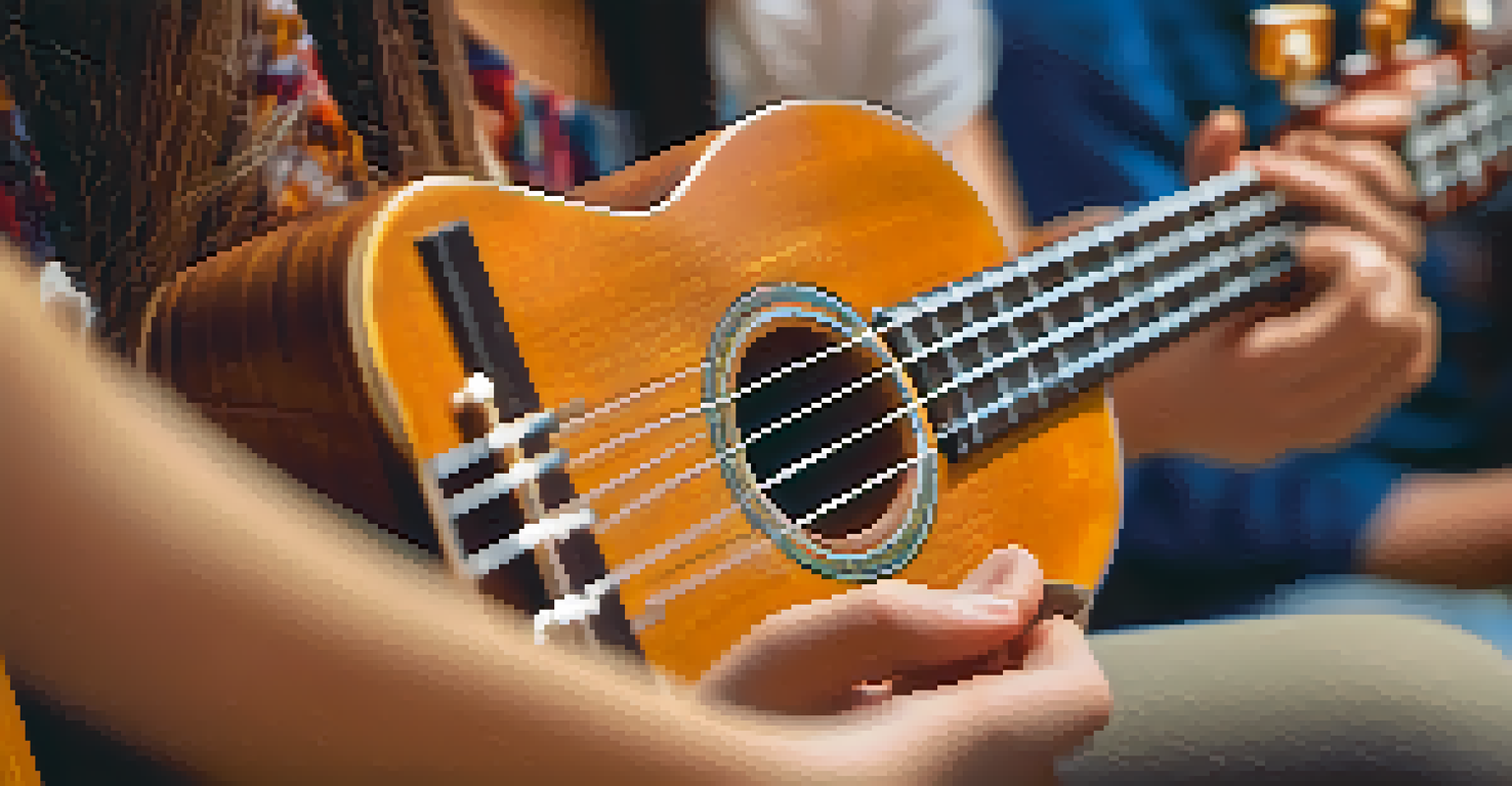Integrating Ukuleles into Middle School Music Curriculum

Why Ukuleles Are Perfect for Middle School Students
Ukuleles are a fantastic choice for middle school music programs because they are small, lightweight, and easy to learn. Unlike some larger instruments, the ukulele’s size makes it accessible for students of all ages. Many kids find the friendly, cheerful sound of the ukulele instantly appealing, which can spark their interest in music.
Music is a world within itself; it’s a language we all understand.
The ukulele typically has only four strings, making it less daunting for beginners compared to guitars or pianos. This simplicity allows students to pick up basic chords quickly, fostering a sense of accomplishment and encouraging continued practice. Plus, the basic chord structures enable young musicians to play along with a wide range of popular songs, making lessons more engaging.
Additionally, the ukulele promotes social interaction through group playing, which is vital in a middle school setting. Students can jam together, share their progress, and even collaborate on projects, building teamwork skills that will benefit them beyond the classroom.
Enhancing Musical Skills Through Ukulele Lessons
Integrating ukuleles into the music curriculum helps students develop essential musical skills. Strumming patterns and finger placements enhance their hand-eye coordination and fine motor skills. As they learn to play, students also gain a better understanding of rhythm and pulse, which are foundational concepts in music.

Moreover, ukulele lessons can serve as a springboard for exploring music theory. Students can learn about scales, intervals, and chord progressions while playing their favorite songs. By visually seeing how chords are formed on the fretboard, students can grasp theoretical concepts in a hands-on way.
Ukuleles Foster Engagement
The ukulele's approachable nature makes learning music fun and engaging for middle school students.
Lastly, these lessons can encourage creativity among students. Once they become comfortable with basic chords, they can start writing their own songs or experimenting with different genres, allowing for self-expression and artistic growth.
Creating a Fun and Engaging Classroom Environment
The ukulele’s approachable nature allows teachers to create a fun and lively classroom atmosphere. Engaging students through popular songs and interactive games can make learning feel less like a chore and more like a celebration. This enthusiasm often leads to higher participation rates and a more vibrant classroom dynamic.
The ukulele is a happy instrument, and when you play it, you can’t help but smile.
Incorporating group activities, such as ukulele circles or ensemble performances, fosters a sense of community among students. This collaborative approach not only builds camaraderie but also encourages students to support each other in their musical journeys. When students feel connected, they are more likely to stay motivated and engaged in their learning.
Additionally, using technology, like online tutorials or apps for practicing, can enhance their learning experience. Students often enjoy using digital tools, making the process of learning the ukulele both modern and enjoyable.
Addressing Diverse Learning Styles with Ukuleles
One of the strengths of the ukulele is its ability to cater to various learning styles. Visual learners can benefit from watching demonstrations and following chord charts, while auditory learners can absorb rhythms and melodies by listening to songs. Kinesthetic learners will thrive as they physically engage with the instrument, developing muscle memory through practice.
Using the ukulele, teachers can design lessons that incorporate all these learning styles, ensuring that every student can connect with the material. For example, a lesson might begin with listening to a song, followed by visual aids that demonstrate chord fingerings, and end with students playing along, engaging all senses.
Supports Diverse Learning Styles
Ukulele lessons cater to various learning styles, ensuring all students can connect with musical concepts.
This inclusive approach not only helps students grasp musical concepts but also builds confidence. When all learning styles are addressed, students feel valued and understood, leading to a more positive educational experience.
Incorporating Cultural Elements into Ukulele Lessons
The ukulele has roots in Hawaiian culture, which provides an excellent opportunity to introduce students to diverse musical traditions. By exploring the history of the ukulele and its cultural significance, teachers can enrich students' understanding of music as a universal language. This cultural context can foster appreciation for different styles and genres.
Incorporating songs from various cultures allows students to experience a broad spectrum of musical expressions. For instance, students can learn traditional Hawaiian songs or even contemporary pieces that reflect diverse cultural backgrounds. This not only enhances their musical repertoire but also broadens their perspectives.
Furthermore, discussions about the origins of the ukulele can inspire students to explore other instruments and cultures, encouraging curiosity and a love for global music. This holistic approach to music education nurtures a sense of belonging and awareness of the world around them.
Assessing Student Progress in Ukulele Lessons
Assessing student progress in ukulele lessons can be both fun and informative. Teachers can use informal assessments, such as group performances or peer reviews, to gauge students' understanding and skills. This approach allows students to learn from each other and provides a more relaxed environment for showcasing their abilities.
In addition to performance assessments, teachers can also incorporate self-assessment tools. Students can reflect on their own progress by setting personal goals or maintaining practice journals. This encourages accountability and helps them take ownership of their musical journey.
Cultural Awareness Through Music
Incorporating the ukulele's cultural roots enriches students' understanding of music as a universal language.
Finally, providing constructive feedback is essential for improvement. Teachers can highlight strengths and areas for growth, fostering a supportive atmosphere where students feel comfortable taking risks and challenging themselves.
Implementing Ukuleles in the Curriculum: Best Practices
When integrating ukuleles into the curriculum, it’s vital to have a structured plan that includes clear objectives and outcomes. Establishing a curriculum map can help teachers outline what they want students to learn over the school year. This roadmap ensures that lessons build on each other, leading to a more cohesive learning experience.
It's also important to provide professional development for teachers. Offering workshops or resources on effective ukulele teaching strategies can help educators feel more confident in their instruction. When teachers are well-prepared, they can foster a more engaging and productive learning environment.

Finally, creating partnerships with local music organizations or ukulele clubs can enhance the program. These collaborations can provide additional resources, performance opportunities, and even guest instructors, enriching the overall ukulele experience for students.